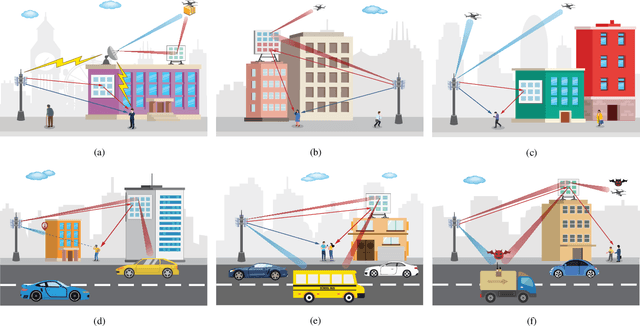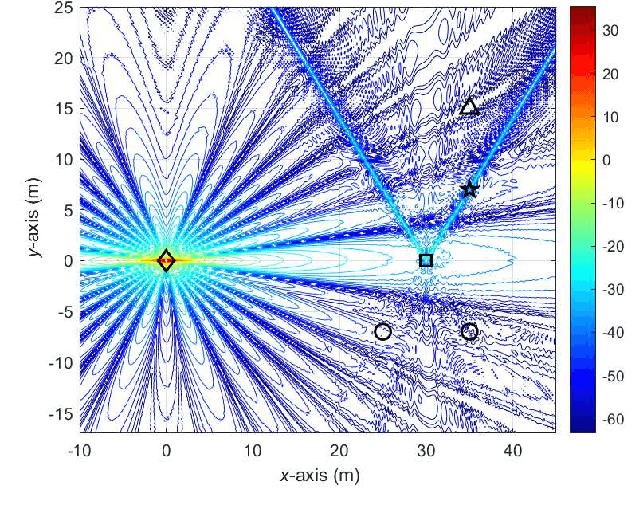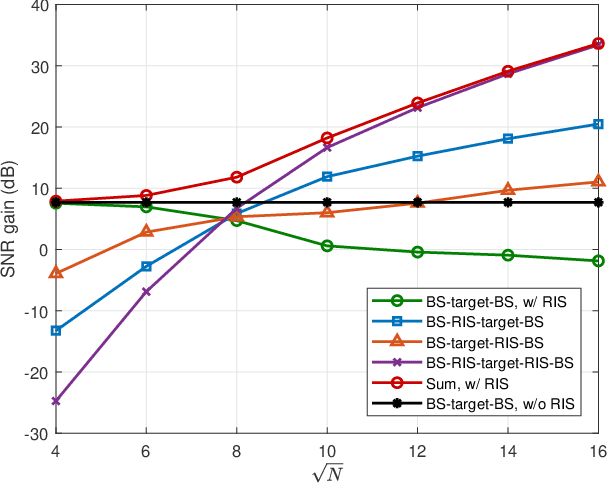Honghao Luo
Active Reconfigurable Intelligent Surface Empowered Synthetic Aperture Radar Imaging
Sep 18, 2024Abstract:Synthetic Aperture Radar (SAR) utilizes the movement of the radar antenna over a specific area of interest to achieve higher spatial resolution imaging. In this paper, we aim to investigate the realization of SAR imaging for a stationary radar system with the assistance of active reconfigurable intelligent surface (ARIS) mounted on an unmanned aerial vehicle (UAV). As the UAV moves along the stationary trajectory, the ARIS can not only build a high-quality virtual line-of-sight (LoS) propagation path, but its mobility can also effectively create a much larger virtual aperture, which can be utilized to realize a SAR system. In this paper, we first present a range-Doppler (RD) imaging algorithm to obtain imaging results for the proposed ARIS-empowered SAR system. Then, to further improve the SAR imaging performance, we attempt to optimize the reflection coefficients of ARIS to maximize the signal-to-noise ratio (SNR) at the stationary radar receiver under the constraints of ARIS maximum power and amplification factor. An effective algorithm based on fractional programming (FP) and majorization minimization (MM) methods is developed to solve the resulting non-convex problem. Simulation results validate the effectiveness of ARIS-assisted SAR imaging and our proposed RD imaging and ARIS optimization algorithms.
RIS-Aided Integrated Sensing and Communication: Joint Beamforming and Reflection Design
Feb 22, 2023Abstract:Integrated sensing and communication (ISAC) has been envisioned as a promising technique to alleviate the spectrum congestion problem. Inspired by the applications of reconfigurable intelligent surface (RIS) in dynamically manipulating wireless propagation environment, in this paper, we investigate to deploy a RIS in an ISAC system to pursue performance improvement. Particularly, we consider a RIS-assisted ISAC system where a multi-antenna base station (BS) performs multi-target detection and multi-user communication with the assistance of a RIS. Our goal is maximizing the weighted summation of target detection signal-to-noise ratios (SNRs) by jointly optimizing the transmit beamforming and the RIS reflection coefficients, while satisfying the communication quality-of-service (QoS) requirement, the total transmit power budget, and the restriction of RIS phase-shift. An efficient alternating optimization algorithm combining the majorization-minimization (MM), penalty-based, and manifold optimization methods is developed to solve the resulting complicated non-convex optimization problem. Simulation results illustrate the advantages of deploying RIS in ISAC systems and the effectiveness of our proposed algorithm.
Joint Beamforming Design for RIS-Assisted Integrated Sensing and Communication Systems
Aug 03, 2022

Abstract:Integrated sensing and communication (ISAC) has been envisioned as a promising technology to tackle the spectrum congestion problem for future networks. In this correspondence, we investigate to deploy a reconfigurable intelligent surface (RIS) in an ISAC system for achieving better performance. In particular, a multi-antenna base station (BS) simultaneously serves multiple single-antenna users with the assistance of a RIS and detects potential targets. The active beamforming of the BS and the passive beamforming of the RIS are jointly optimized to maximize the achievable sum-rate of the communication users while satisfying the constraint of beampattern similarity for radar sensing, the restriction of the RIS, and the transmit power budget. An efficient alternating algorithm based on the fractional programming (FP), majorization-minimization (MM), and manifold optimization methods is developed to convert the resulting non-convex optimization problem into two solvable sub-problems and iteratively solve them. Simulation studies illustrate the advancement of deploying RIS in ISAC systems and the effectiveness of the proposed algorithm.
Integrated Sensing and Communication with Reconfigurable Intelligent Surfaces: Opportunities, Applications, and Future Directions
Jun 17, 2022



Abstract:Integrated sensing and communication (ISAC) is emerging as a key enabler to address the growing spectrum congestion problem and satisfy increasing demands for ubiquitous sensing and communication. By sharing various resources and information, ISAC achieves much higher spectral, energy, hardware, and economic efficiencies. Concurrently, reconfigurable intelligent surface (RIS) technology has been deemed as a promising approach due to its capability of intelligently manipulating the wireless propagation environment in an energy and hardware efficient manner. In this article, we analyze the potential of deploying RIS to improve communication and sensing performance in ISAC systems. We first describe the fundamentals of RIS and its applications in traditional communication and sensing systems, then introduce the principles of ISAC and overview existing explorations on RIS-assisted ISAC, followed by one case study to verify the advantages of deploying RIS in ISAC systems. Finally, open challenges and research directions are discussed to stimulate this line of research and pave the way for practical applications.
 Add to Chrome
Add to Chrome Add to Firefox
Add to Firefox Add to Edge
Add to Edge